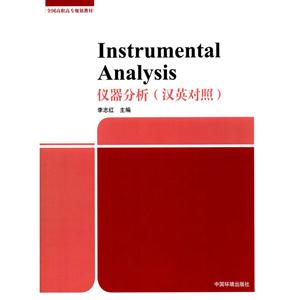中文导读:1电位分析法 1.1原理简介 1.2能斯特方程的应用 1.3离子选择电极 1.4直接电位法 1.5电位滴定法 1.6电位滴定法的实验数据处理 1.7电位测定相对误差评价 chapter 1 potentiometry 1.1 introduction 1.2 indicator electrodes 1.3 ion selective electrode (ph electrode) 1.3.1 metallic electrodes 1.3.2 membrane electrodes 1.3.3 glass membrane electrodes 1.3.4 crystalline solid—state electrodes 1.3.5 liquid membrane ises 1.4 analytical applications of potentiometry 1.4.1 direct measurement of an ion concentration 1.4.2 potentiometric titrations 1.4.3 ph measurements 1.4.4 errors in ph measurement with glass electrodes 1.4.5 ph titrations 1.4.6 titrations of weak acids and bases 1.5 suggested experiments 1.6 problems 中文导读:2紫外—可见分光光度法 2.1相关知识 2.2原理简介 2.3分光光度计 chapter 2 ultraviolet and visible absorption spectroscopy 2.1 introduction 2.2 electromagnetic radiation 2.2.1 what is electromagnetic radiation 2.2.2 uv—vis spectmm 2.3 molecules and molecular spectroscopy 2.3.1 rotational transitions in molecules 2.3.2 vibrational transitions in molecules 2.3.3 electronic transitions in molecules 2.4 lambert—beer's law 2.4.1 absorbance and transmittance 2.4.2 lambert—beer's law 2.4.3 deviations from beer's law 2.5 instrumentation in the uv/visible 2.5.1 radiation source 2.5.2 wavelength selection device 2.5.3 sample holder 2.5.4 detector 2.5.5 single—beam and double—beam instruments 2.6 quantitative analysis by absorption measurements 2.6.1 procedural details 2.6.2 methods in quantitative analysis 2.6.3 analysis of mixtures of absorbing substances 2.7 accuracy&precision in uv/vis absorption spectrometry 2.8 suggested experiments 2.9 problems 中文导读:3原子吸收分光光度法 3.1基本原理 3.2原子吸收分光光度仪主要部件功能简介 chapter 3 atomic absorption spectroscopy 3.1 introduction 3.2 absorption of radiant energy by atoms 3.2.1 boltzmann distribution 3.2.2 measurements by atomic absorption 3.3 instrumentation 3.3.1 radiation sollrces 3.3.2 atomizers 3.3.3 monochromator 3.3.4 detectors 3.4 correction of interfering absorptions 3.5 analytical applications of aas 3.5.1 qualitative analysis 3.5.2 quantitative analysis 3.6 suggested experiments 3.7 problems 中文导读:4气相色谱分析法 4.1色谱法简介 4.2基本原理 4.3色谱法的分类 4.4气相色谱仪及色谱流出曲线图 4.5组分与固定相的作用 4.6程序升温技术 4.7色谱分离基础理论 4.8衡量总体分离效果的指标——分离度r chapter 4 gas chromatography 4.1 introduction 4.2 background in formation of chromatography 4.3 general concepts of analytical chromatography 4.4 the chromatogram 4.5 retention parameters 4.5.1 retention times 4.5.2 retention volume (or elution volume) vr 4.5.3 hold—up volume (or dead volume) vm 4.5.4 retention (or capacity) factor k 4.6 separation factor between two solutes 4.7 resolution factor between two peaks 4.8 techniques by physical state of mobile phase 4.8.1 gas chromatography(gc) 4.8.2 liquid chromatography (lc) 4.9 essential theories of chromatography 4.9.1 the plate theory 4.9.2 the rate theory of chromatography 4.9.3 golay's equation 4.10 optimization of a chromatographic analysis 4.11 gas chromatography 4.11.1 components of a gc installation 4.11.2 mobile phase 4.11.3 chromatographic columns 4.11.4 stationary phases 4.11.5 sample introduction 4.11.6 temperature control 4.11.7 detectors for gas chromatography 4.12 quantitative analysis 4.12.1 analyses based on peak height 4.12.2 analyses based on peak areas 4.12.3 calibration and standards 4.12.4 the internal—standard method 4.12.5 the area—normalization method 4.12.6 quantitative applications of gc 4.13 qualitative analysis 4.13.1 the retention index 4.13.2 evaluation 4.13.3 gc coupled with spectroscopic detection 4.14 problems 中文导读:5高效液相色谱分析法 5.1 高效液相色谱简介 5.2高效液相色谱法与气相色谱法的比较 5.3高效液相色谱主要类型 5.4高效液相色谱仪 5.5梯度洗脱技术 chapter 5 high—performance liquid chromatography 5.1 introduction 5.2 the beginnings of hplc 5.3 general concept of an hplc system 5.4 pumps and gradient elution 5.4.1 pumps 5.4.2 low and high pressure gradients 5.7 stationary phases 5.9 detectors for hplc 5.10 quantitative applications 5.12 evolution and applications of hplc 5.13 problems …… 中文导读:6红外光谱法 chapter 6 infrared spectroscopy 中文导读:7质谱法 chapter 7 mass spectrometry


















